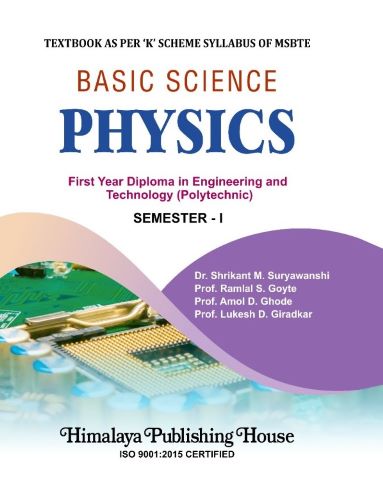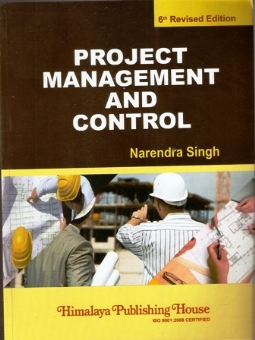It gives us great pleasure to present a Textbook ‘Basic Science – Physics’ (Semester – 1) for Engineering Diploma (Polytechnic) students. This Textbook is designed to serve as a comprehensive resource for first year diploma students as per ‘K’ scheme of MSBTE updated syllabus. This book is also suitable as a reference for the syllabus of other boards and universities.
In each and every unit all articles are given with deep knowledge and explained in a simple language with proper Diagrams. Every student will easily be able to understand given concepts of all articles, also in between the units some solved questions are given with their detailed solution. After every unit we provide maximum multiple choice questions (MCQs) with specific answers, due to this every student can score good marks in their semester examinations.
Contents –
1. Units and Measurements
1.1 Introduction
1.1.1 Units and Different Systems of Units
1.1.2 Physical Quantities
1.1.3 Prefixes to Units
1.1.4 Difference between Fundamental Quantities and Derived Quantities
1.2 Dimension and Dimension Analysis
1.2.1 Important Terminology
1.2.2 Application of Dimensional Analysis
1.3 Scalars and Vectors
1.3.1 Introduction
1.3.2 Scalars and Scalar Quantities
1.3.3 Vectors or Vector Quantities
1.3.4 Properties
1.3.5 Difference between Scalars and Vectors
1.4 Errors and Estimation of Errors
1.4.1 Instrumental (or Constant Error)
1.4.2 Systematic Errors
1.4.3 Random Errors
1.4.4 Estimation of Errors
1.5 Significant Figures, Rules and Identification of Significant Figure
1.5.1 Rules for Determining Significant Figures
1.5.2 Rounding of Approximate Numbers
1.6 Ancient Astronomical Instruments – Chakra, Dhanu Yantra, Yasti and Phalaka Yantra
1.6.1 Chakra Yantra
1.6.2 Dhanu Yantra
1.6.3 Yasti Yantra
1.6.4 Phalaka Yantra
1.7 Applications of Vernier Callipers, Micrometer Screw Gauge
1.7.1 Applications of Vernier Callipers
1.7.2 Applications of Micrometer Screw Gauge
1.8 Important MCQs
2. Electricity, Magnetism and Semiconductors
2.1 Electrostatics
2.1.1 Concept of Electric Charge
2.1.2 Coulomb’s Inverse Square Law
2.1.3 Electric Field
2.1.4 Electric Field Intensity (Electric Field Strength)
2.1.5 Electric Lines of Force (Electric Field Lines)
2.1.6 Electric Flux (ψ)
2.1.7 Electric Flux Density (D)
2.1.8 Electric Potential and Potential Difference
2.1.9 Electric Potential Due to Point Charge
2.1.10 Potential Difference between Two Points
2.2 Magnetism
2.2.1 History of Magnetic Field
2.2.2 Magnetic Field and Magnetic Field Intensity
2.2.3 Magnetic Lines of Force
2.2.4 Magnetic Flux (ϕ) and Magnetic Flux Density (B)
2.2.5 Relation between Magnetic Flux Density (B) and Magnetic Field Intensity (H)
2.3 Current Electricity
2.3.1 Introduction
2.3.2 Resistance (R) and Resistivity (ρ)
2.3.3 Conductance (G) and Conductivity (σ)
2.3.4 Ohm’s Law
2.3.5 Combination of Resistances
2.3.6 Galvanometer and its Conversion into Ammeter and Voltmeter
2.3.7 Heating Effect of Electric Current
2.4 Semiconductors Physics
2.4.1 Band Theory of Solids: Introduction
2.4.2 Energy Band Diagrams for Conductors, Semiconductors and Insulators
2.4.3 Classification of Solids on the Basis of Band Theory
2.4.4 Intrinsic and Extrinsic Semiconductors
2.4.5 Difference between Intrinsic and Extrinsic Semiconductor
2.4.6 Minority and Majority Charge Carriers
2.5 P-N Junction Diode
2.5.1 P-N Junction Formation
2.5.2 Depletion Layer
2.5.3 I-V Characteristics of P-N Junction
2.5.4 Static and Dynamic Resistance of Diode
2.5.5 Half-Wave Rectifier
2.6 Important MCQs
3. Thermometry and Fibre Optics
3.1 Heat, Temperature and Temperature Scales
3.1.1 Heat
3.1.2 Temperature
3.1.3 Units of Heat and Temperature
3.2 Modes of Transfer of Heat
3.2.1 Conduction
3.2.2 Convection
3.2.3 Radiation
3.2.4 Comparison between Conduction, Convection and Radiation
3.3 Gas Laws and Gas Equations
3.3.1 Boyle’s Law
3.3.2 Charles’ Law
3.3.3 Gay-Lussac’s Law
3.3.4 Perfect Gas Equation and Universal Gas Constant
3.4 Thermal Conductivity and Newton’s Law of Cooling
3.4.1 Thermal Conductivity and Coefficient of Thermal Conductivity
3.4.2 Newton’s Law of Cooling
3.5 Reflection, Refraction, Totals Internal Reflection
3.5.1 Reflection
3.5.2 Refraction of Monochromatic Light
3.5.3 Total Internal Reflection (T.I.R.)
3.6 Optical Fibre – Principle, Construction and Working
3.6.1 Construction of Optical Fibres
3.6.2 Principle of Operation of Optical Fibres
3.6.3 Working of Optical Fibre
3.6.4 Acceptance Angle (θa)
3.6.5 Numerical Aperture
3.6.6 Propagation of Light in Optical Fibre
3.6.7 Types of Optical Fibres
3.6.8 Advantages of Optical Fibres in Communication Over Ordinary Cable Communication
3.6.9 Applications of Optical Fibres
3.7 Important MCQs






